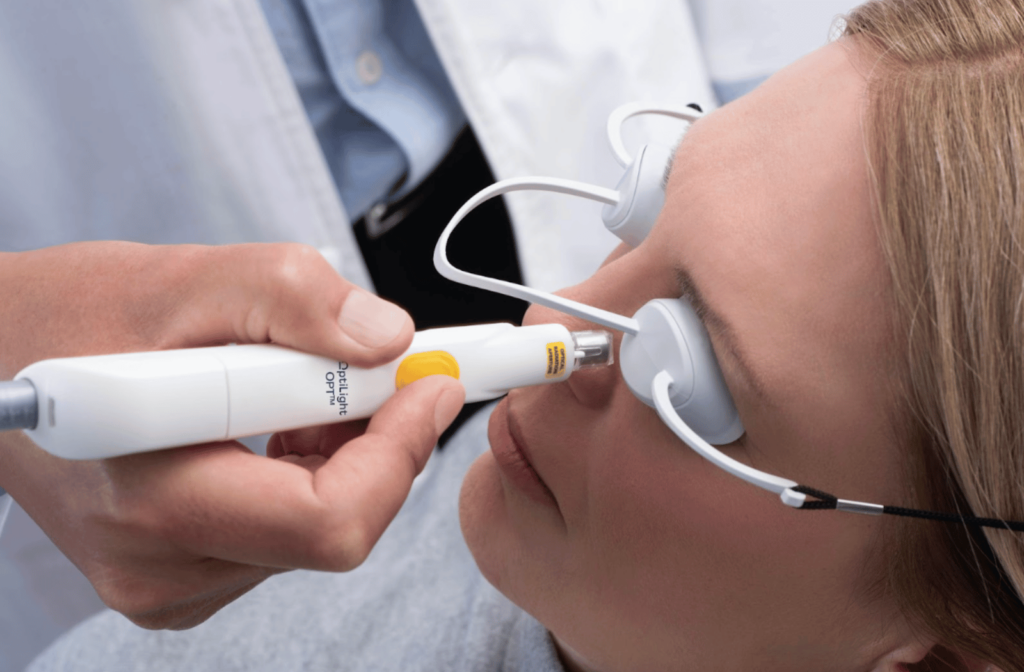Dry eyes can be frustrating and disruptive. It’s a common issue for many people. Although various home remedies and treatments are available for dry eyes, some patients experience no—or only temporary—relief from these solutions.
Fortunately, intense pulsed light (IPL) treatment is an effective solution for dry eyes. IPL uses carefully attuned light pulses to release blockages in the oil glands that contribute to dry eye symptoms. OptiLight by Lumenis is the only FDA-approved IPL treatment for dry eyes and can help support long-lasting relief from dry eye discomfort.
What Is Dry Eye Syndrome?
Dry eye syndrome occurs when the eyes don’t produce enough tears or the quality of the tears they make is poor. Tears are crucial for healthy, comfortable eyes. They help lubricate, protect, and nourish the eyes and contain essential nutrients that fight infections. When the eyes don’t produce a sufficient amount of tears or make poor-quality tears, you can develop symptoms like:
- Dryness and discomfort
- Burning or stinging
- Redness and irritation
- Excessive tearing
- Blurred vision
- Sensitivity to light
- Eye fatigue
Various factors can contribute to dry eyes, so it’s essential to uncover the underlying cause so an effective treatment can be prescribed.
Insufficient Tear Production
Insufficient tear production, also known as aqueous-deficient dry eye, occurs when the eyes don’t produce enough tears, leading to discomfort, irritation, and other symptoms. It’s the least common form of dry eyes.
Several factors can contribute to insufficient tear production, including:
- Age: As we get older, tear production tends to decrease, leading to a higher risk of dry eye syndrome.
- Environmental factors: Dry and windy climates and exposure to air conditioning or heating systems can contribute to dry eyes.
- Medical conditions: Certain conditions such as diabetes, rheumatoid arthritis, Sjögren’s syndrome, and thyroid disorders can affect tear production.
- Medications: Some medications, including antihistamines, decongestants, antidepressants, and hormone replacement therapy, can cause dry eyes as a side effect.
- Extended screen time: Prolonged use of digital devices can reduce blinking frequency and lead to dry eyes.
Poor Tear Quality
Poor tear quality, or evaporative dry eye, occurs when the tears produced by the eyes are insufficient to effectively lubricate and protect the eye’s surface. Tears are composed of water, oil, and mucus, with antibodies all working together to keep the eyes moist, clear, and free from debris.
When tear quality is compromised, it can lead to various symptoms and complications. Some factors that can contribute to poor tear quality include:
- Meibomian gland dysfunction (MGD): This is the most common form of dry eyes. The meibomian glands in the eyelids produce an oily substance that prevents tears from evaporating too quickly. Dysfunction of these glands can result in a lack of oil in the tears, leading to evaporation and dryness.
- Blepharitis: This is an inflammation of the eyelids, often caused by bacteria or skin conditions such as rosacea. It can affect the quality of the oils produced by the meibomian glands, resulting in poor tear quality.
- Autoimmune diseases: Certain autoimmune conditions, such as Sjögren’s syndrome, can damage the tear-producing glands, resulting in inadequate production of tears with improper composition.
- Medications: Some medications, such as acne medications, antihistamines, and certain blood pressure medications, can affect tear quality as a side effect.
- Nutritional deficiencies: Inadequate intake of essential fatty acids, vitamin A, and other nutrients necessary for proper tear production and maintenance can contribute to poor tear quality.
If you experience these symptoms, consult your eye care professional for a comprehensive evaluation and appropriate treatment.
What Is IPL & How Does It Help Dry Eyes?
IPL therapy is a non-invasive and non-surgical procedure that uses flashes of intense, broad-spectrum light to treat various skin issues like age spots, rosacea, and broken blood vessels. OptiLight is the FDA-approved IPL treatment designed exclusively to treat dry eyes caused by MGD.
MGD occurs when inflammation in the meibomian glands prevents the production of the essential oils needed by your tears to stop your tears from evaporating too quickly. IPL treatment reduces inflammation in the meibomian glands, improving oil production.
When the glands function appropriately, the tear film is stabilized, and dry eye symptoms are relieved.
What to Expect During IPL Treatment
IPL therapy is an in-office treatment that only takes 15 to 30 minutes. You may experience some discomfort during the procedure as the light pulses are delivered. Some describe the sensation as a mild rubber band snapping against the skin, while others report only feeling warmth.
After applying an eye shield and ultrasound gel, your optometrist will use a device with an adjustable filter to generate light pulses that target the area around the eyes. The light energy is absorbed by skin cells and the blood vessels to stimulate the breakdown of blockages.
Although IPL treatment for dry eyes usually requires multiple sessions, patients should notice a significant improvement in their dry eye symptoms within weeks.
How Long Do IPL Results Last?
IPL treatments can provide 6 months to a year of relief from dry eye symptoms after a series of visits with maintenance sessions to support long-term results. However, it’s important to note that the duration of IPL results may vary depending on individual factors, such as:
- The root cause of your dry eyes
- The severity of your dry eyes
- Your response to treatment
- The treatment frequency
Relieve Dry Eye Discomfort
Dry eyes can be frustrating and uncomfortable, but there is hope with IPL treatment. If you’re struggling with dry eyes and looking for a long-lasting solution, IPL therapy administered by a trusted optometrist at Precision Eye Care can help improve your quality of life. Visit us for a dry eye diagnosis and a personalized treatment plan to find relief from dry eyes.




